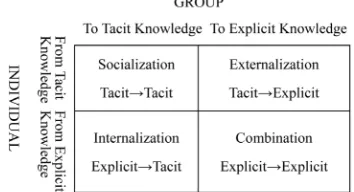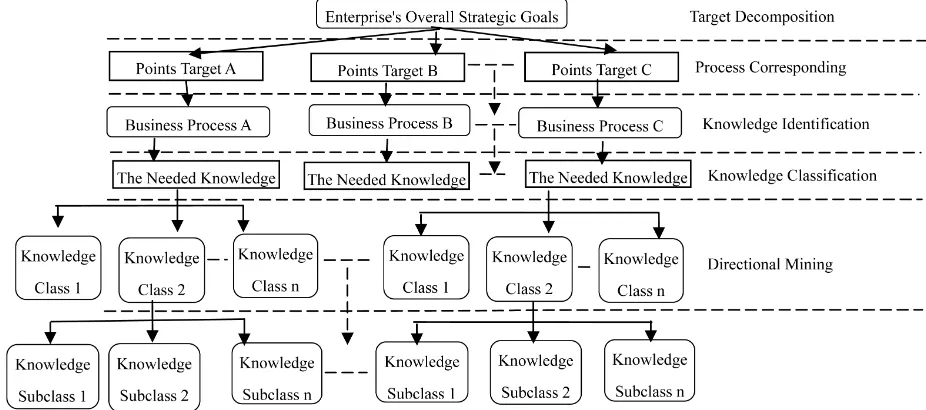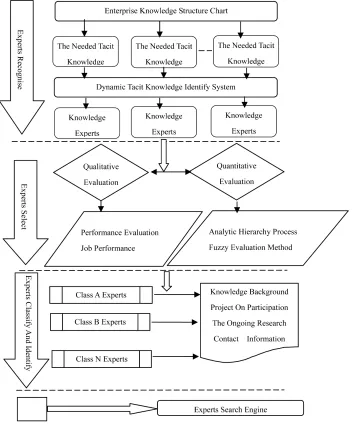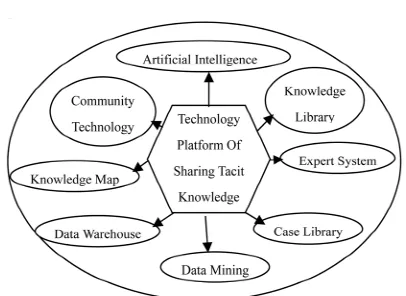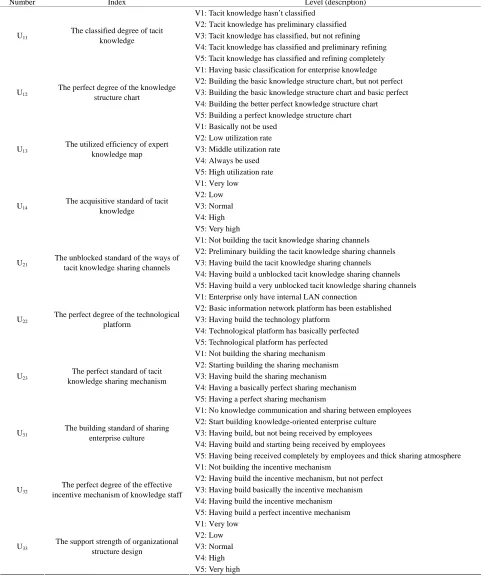Case Study on Tacit Knowledge Management Systems
within X Company
*
Jiangping Wan1,2, Ming Zeng1, Yahui Zhu1 1
School of Business Administration, South China University of Technology, Guangzhou, China 2
Institute of Emerging Industrialization Development, South China University of Technology, Guangzhou, China Email: scutjsp@126.com, zm656690@qq.com, zhuyahui0819@qq.com
Received February 12, 2013; revised March 29, 2013; accepted April 6, 2013
Copyright © 2013 Jiangping Wan et al. This is an open access article distributed under the Creative Commons Attribution License, which permits unrestricted use, distribution, and reproduction in any medium, provided the original work is properly cited.
ABSTRACT
Case study on tacit knowledge management system within X company includes the design of tacit knowledge manage-ment system (the recognition and acquisition of tacit knowledge), mechanisms (the factor analysis for the transition and sharing of tacit knowledge) and implementation (the sharing enterprise culture build, the effective incentive mechanism construct and the organization structure design). The evaluation system is established based on critical success factors (the recognition capability, the sharing standard, the sharing mechanism of tacit knowledge). The purpose of study is to improve tacit knowledge management system within enterprise.
Keywords: Explicit Knowledge; Tacit Knowledge; Knowledge Conversion; Tacit Knowledge Management Systems; Case Study
1. Introduction
Michael Polanyi divided knowledge into tacit knowledge and explicit knowledge [1]. Tacit knowledge exists in human brains, which is the knowledge that people don’t know, in other words people don’t know what they know. Verna Allee thought that tacit knowledge which exists in individuals is private and has its own special background, and it also depends on experience, intuition and discern-ment [2]. Nonaka figured that organizations create and make use of knowledge via the interaction of tacit knowledge and explicit knowledge, which is called knowledge conversion process [3].
X company is a global management consulting, tech-nology services and outsourcing company, with ap-proximately 259,000 people serving clients in more than 120 countries. X company, which owns unparalleled ex-perience, comprehensive capabilities across all industries and business functions, and extensive research on the world’s most successful companies, collaborates with clients to help them become high performance businesses and governments.
X company has conducted business more than twenty years in the greater China region, which locates in
Bei-jing, Shanghai, Dalian, Chengdu, Guangzhou, Hong Kong and Taipei. X company, an expert for performance improvement, helps customers determine strategy, opti-mize the process, integrate system, import innovation, enhance the overall competitive advantage, thus achieves great excellent performance. Its senior managers also carry out successful knowledge management practice within its interior, sharing knowledge has become the long-standing culture while X company helps customers manage knowledge effectively. The success for X com-pany largely benefits from its strong knowledge man-agement system.
This paper is organized in the following: Section 2 is a literature review, including Nonaka’s framework of know- ledge creation mechanisms, the concept of knowledge conversion, and knowledge management in software process improvement (SPI). Section 3 is tacit know- ledge management systems (TKMS) design. Section 4 is TKMS mechanisms. Section 5 is TKMS implementation. Section 6 is TKMS evaluation. Section 7 is conclusion.
2. Literature Review
Language is an excellent example of tacit knowledge: native speakers of a language are often unable to articu-late the grammatical and syntactic rules governing it. Tacit knowledge contributes to the “stickiness” of
infor-*This research was supported by Key Project of Guangdong Province
mation required for problem-solving, making it difficult for others to gather, transfer, and utilize. The difficult to codify nature of tacit knowledge contributes to difficult to imitate capabilities that may provide competitive ad-vantage to the organization. Success of process im-provement projects depends on the capture of both ex-plicit and tacit types of knowledge [4].
The concept of “tacit knowledge” is a cornerstone in organizational knowledge creation theory and covers knowledge that is unarticulated and tied to the senses, movement skills, physical experiences, intuition, or im-plicit rules of thumb. Knowledge of wine tasting, crafting a violin, or interpreting a complex seismic printout of an oil reservoir is well-known examples of tacit knowledge. Tacit knowledge differs from “explicit knowledge” that is uttered and captured in drawings and writing. For ex-ample, knowledge of a solution to a differential equation is explicit knowledge. The concept of “knowledge con-version” explains how tacit and explicit knowledge in-teract along a continuum [4].
Nonaka’s framework [3] provides a rationale for the use of knowledge-creation practices to generate group knowledge by engaging individual team members in process improvement projects. The framework depicts the process of knowledge creation as cycles of conver-sions between two types of knowledge—explicit, and tacit (Figure 1). It is worthwhile to note that this classi-fication of knowledge as either explicit or tacit is one of two prominent classifications in the knowledge man-agement literature (Table 1 provides a brief overview of different classifications of knowledge creation efforts [5]). Explicit knowledge is codified and documented, and its transfer can take place in impersonal ways—for in-stance, through written instructions and diagrams. Tacit knowledge is knowledge that is difficult to articulate, especially in terms of cause-effect relationships.
Knowledge transfer model of software process im-provement (SPI) and the conceptual framework of influ-encing factors are established in [6]. The model includes five elements which are knowledge of transfer, sources of knowledge, recipients of knowledge, relationship of transfer parties, and the environment of transfer.
[image:2.595.333.510.90.186.2]The conceptual framework includes ten key factors which are ambiguity, institutionalization, transfer will-ingness, capacity of impartation, capacity of absorption, incentive mechanism, culture, technical support, trust and knowledge distance. The knowledge creation effective factors were found in both necessary elements for stimu-lus of knowledge creation and the key influencing factors of software project success [7]. The knowledge creation effective factors in requirement development project are clarified through deeply interviewing the software enter-prises in Guangdong province as well as other corporate
Figure 1. Nonaka’s framework of knowledge-creation me- chanisms.
Table 1. Selected classifications of knowledge creation me- chanisms.
Author(s) Year Knowledge creation mechanisms
Argyris 1977 Single & double loop learning
Nonaka 1991 Combination, internalization,
socialization & externalization
Kogut and
Zander 1992 Operational & conceptual
Spender 1996 Capturing individual and
organizational knowledge
Nahapiet and
Ghoshal 1998 Acquiring intellectual & social capital
[image:2.595.307.537.253.391.2]3. Tacit Knowledge Management Systems
Design
X company strengthens enterprise tacit knowledge man-agement to convert the enterprise knowledge assets into tangible assets for sustainable competitive advantage. It is necessary to manage the tacit knowledge that we must have a explicit understanding on both the purpose and function of tacit knowledge management for recognition and acquirement tacit knowledge.
3.1. The Purpose, Function of Tacit Knowledge Management
Tacit knowledge management can achieve the following purpose and function within an enterprise: 1) Enhance the enterprise’s strain and innovation capacity. Tacit knowledge management improves enterprise organiza-tion’s strain and innovation capacity with the knowledge sharing and collective wisdom; 2) Prevent the loss of enterprise’s core knowledge. Tacit knowledge manage-ment can prevent a heavy loss that enterprise’s knowl-edge staff or technician leaving office; 3) Improve the organization efficiency. With obtaining and sharing the best experience, enterprise can shorten the operation time and minimize the repeated work, so as to improve the organization efficiency.
3.2. The Recognition of Tacit Knowledge
It is necessary to recognize knowledge for managing tacit knowledge in X company. It should be to make internal tacit knowledge transparent, find out the knowledge which can create the most value, where and who needs these knowledge, who controls these knowledge, then
describe the relationship between the personnel, work and tacit knowledge, it is necessary for achieving the communication and sharing of tacit knowledge.
3.2.1. The Classification of Tacit Knowledge
X company classifies the tacit knowledge as follow: 1) It can be divided into practice, impart and innovative ac-cording to the different approach which the knowledge staff obtains tacit knowledge; 2) It can be divided into encoding, not easy coding and can’t coding according to the degree of coding; 3) It can be divided into individual, team and enterprise according to the different degree that group locates in; 4) It can be divided into apparent, tran-sitional, matured according to the cognition degree of tacit knowledge owner to tacit knowledge and the inno-vated degree of tacit knowledge.
3.2.2. Enterprise Knowledge Structure Chart Build
[image:3.595.65.528.511.716.2]Knowledge structure chart refers to a chart in a method refine knowledge based from big to small, from thick to thin, from general to professional, in the form of tree hierarchical structure, decomposed the organize knowl-edge of layers. The method of building enterprise knowledge structure chart is: first of all, enterprise man-agers should determine enterprise’s overall strategic goals according to inner and outer environment. Then, the enterprise’s overall goal is deeply analysed, the over-all goal into different points target is decomposed, and the corresponding business process is recognized. Next, all knowledge are recognized which needed during real-izing each business process, classify the knowledge ac-cording to attributes levels. Last, it is to excavate the identified knowledge with directional mining method on the basis of classification (Figure 2).
3.2.3. Expert Knowledge Map Build
The building process of expert knowledge map for X company is: The recognition of enterprise knowledge experts; the selection of experts; the classification and recognition of knowledge experts; establish a search en-gine of knowledge experts; expand expert knowledge map’s content, improve in the repeated evaluation; pre-cipitate experts’ tacit knowledge (Figure 3).
3.3. Tacit Knowledge Obtain
X company acquires apparent tacit knowledge through on-the-scene observation, experience, imitation and crowd test; acquires the matured tacit knowledge through the man-machine auxiliary experiment to speed up the tacit knowledge refinement, finds problems and tacit knowledge kernel with the help of computer through the
ideas of the simulation system with low cost; we can obtain by on-the-scene observation, experience, mentor-ing with statistics for the transient state of tacit knowl-edge.
4. Tacit Knowledge Management Systems
Mechanism
4.1. The Factor Analysis of Affecting Tacit Knowledge Transition and Sharing
4.1.1. Analysis in the Perspective of Human Nature
[image:4.595.124.477.298.727.2]Tacit knowledge owners usually have forestall and mo-nopoly psychology, leading tacit knowledge difficult to automatic communicate and transform, plus the unfair phenomenon of domestic enterprises “knowledge trans-action” widespread, it accelerates staff and organization
owned tacit knowledge to protect their own intellectual property rights and also further intensifies this kind of psychology. Knowledge receiver have conflicted psy-chology. The reasons are primary in the following: the competitive concept is not clear, the “hide privacy” psy-chology, “knowledge island” phenomenon.
4.1.2. Analysis from Perspective of Enterprise Culture
At present there is a common misunderstanding within the organization, such as the solutions provided by senior members are better than the ones provided by primary members. The organization should avoid measuring the quality of knowledge by position, it should be judged with the knowledge of the contribution and fitness. Moreover, the team members lack direct dialogue space, many organizations only pay more attention to the infra-structure construction, but ignore to create a good dia-logue environment for team members, thus appear the situation that the members of the organization have the desire of communication but without communication place. Moreover, team members lack necessary trust be-tween each other. The basis of knowledge transition is credit. Credit refers to “believe” or “trust” according to the view of Davenport. Because different people have different evaluation about the significance, value, mean-ness of knowledge, the conclusion may be different, so the team members have different sense of approval for the same view between each other, inevitably lack of trust. Finally, team members lack common language. Communication between both have a big difference with the knowledge basis and communication barriers, it is also difficult to promote tacit knowledge transform and the realization of enterprise knowledge sharing.
4.1.3. Analysis from the Perspective of Characteristics of the Knowledge Itself
First of all, knowledge itself has unique scarcity. Sec-ondly, tacit knowledge has media nonverbal characteris-tics. One of the characteristics for tacit knowledge is ex-isting in the form of the language, secondly, the needed time of study also becomes a factor interfered with the propagation of tacit knowledge, the distance also pro-duces influence and difficulty for the propagation of tacit knowledge. Thirdly, tacit knowledge has unconscious characteristics, first of all, it often makes people ignore the existence of tacit knowledge, secondly, from the per-spective of personal use, we usually don’t need to make it clarify and consume a large time for only using the tacit knowledge; many expression form of tacit knowl-edge are thought no value. Some individuals who own the tacit knowledge of unique value usually don’t want to transfer and share. Finally, tacit knowledge as a kind of capability can bring value to a person.
4.1.4. Analysis from the Perspective of Management Institution
First of all, enterprise tacit knowledge flow does not adapt to enterprise organization structure. The traditional organization structure uses the pyramid hierarchical or-ganization structure, although this kind of oror-ganization structure improves the labor productivity to some extent, it will appear the following disadvantages with the de-velopment of society: it is difficult for knowledge and information communication, it is difficult staff creativity, it is difficult to adapt the changeable environment quickly. Moreover, without organization incentive sys-tem, it is difficult to measure knowledge sharing per-formance effectively. People are competitive inherently, they also show self-satisfaction for owing the knowledge others lacked, and even keep a secret, make themselves become the owner of the scarce resources and have the superiority. It is difficult for X company let employees share their knowledge. The traditional organization per-formance appraisal system doesn’t put the employee’s knowledge contribution in an important position which should be. There are incentive systemic problems, the adaptability of the incentive problem, the effectiveness of the incentive problem, incentive innovation question and other kinds of problems incentive system in fact within enterprise.
4.2. Sharing Tacit Knowledge
4.2.1. Ways for Sharing Tacit Knowledge
or-ganization should gather, select, classify, sort and storage to the organizational case library with the numerous se-cure knowledge, so the past work experiences of organi-zation and decision-making cases can become repeated using resources. In the sharing phase, the organization provide case sharing platform in the internal organization, so that employees can extract the ways of solving related problems quickly through the case study, not all start from all over again, and avoid the waste of resources. In the innovation phase, employees blend tacit knowledge acquired from case in its own knowledge system through integration and internality, and apply knowledge in the actual work practice, arouse a new valuable tacit knowl-edge; 6) Establish experts group. Organization should strengthen the effective supervision and support during assembling experts group to make sure that questions can get a satisfactory answer asked by employees; 7) Keep experience communication conferences. In the experi-ence communication conferexperi-ences, the content of the em-ployees expressed bases on their own knowledge back-ground, every employee submit their knowledge in the process, understand and learn other people’s knowledge, so as to realize the knowledge sharing; 8) Establish in-terest groups. Group determines the project based on the analysis of enterprise internal question; 9) Establish elec-tronic network. It is an important channel which making the knowledge sharing both sides get rid of space, time limit and ignoring the organization internal hierarchy relationship to realize the knowledge sharing to a certain extent.
4.2.2. Technology Platform of Sharing Tacit Knowledge
It should solve two basic questions for realizing knowl-edge sharing. First, construct the enterprise information network which covers all business activities of the enter-prise and guarantee that the enterenter-prise has a smooth physical channel in each information release point and information collection point in the complex survival en-vironment; Second, the application software systems should be developed to meet the needs of enterprise (Figure 4).
4.2.3. Institution of Sharing Tacit Knowledge
The institution of sharing tacit knowledge in X company includes the following aspects: the institution of knowl-edge classification and standardization, the institution of knowledge document accumulation and update, the in-stitution of the internalization of external knowledge, the institution of intellectual property rights protection.
[image:6.595.321.524.76.224.2]The institution of knowledge classification and stan-dardization refers to that the classification of enterprise knowledge can not only be in a accordance with post and professional classification, but also can be in accordance
Figure 4. Technical platform of sharing tacit knowledge within X company.
with the local knowledge and global knowledge, routine knowledge and exception knowledge in order to make the knowledge enterprises’ tacit knowledge share and apply better. Local knowledge refers to the knowledge sharing in a team, a department of enterprise, and global knowledge refers to knowledge sharing in all the de-partments of enterprise. Routine knowledge refers to knowledge that can numerable, standardized process and have matured through the test of practice. Exception knowledge refers to a kind of personal technical skill, experience knowledge which has not rules or is difficult to encode only happening in emergencies.
The institution of knowledge document accumulation and update refers to enterprise's professional knowledge managers organize technical skill, best practice and sort-ing into writsort-ing material, organize the enterprise strategy and good marketing methods and technology into be-come materials, then classify and keep in the archives, it can be shared for enterprise employees. The institution of updating knowledge document refers that the knowledge manager reviews the archived files in regulated time to see whether the contents are outdated, invalid, multiple and conflict.
The institution of the internalization of external knowledge refers to transform the knowledge of external experts and scholars into the enterprise’s internal knowl-edge.
5. Tacit Knowledge Management Systems
Implementation
X company achieves the tacit knowledge management through building the sharing enterprise culture, con-structing the effective incentive mechanism of the tacit knowledge sharing, optimizing and designing organiza-tion structure.
5.1. Building Sharing Enterprise Culture
Cultivates sharing type enterprise culture within X com-pany mainly has the following steps: 1) Enterprise senior leaders’ attention and participation. Enterprise senior leaders’ attention can build a good atmosphere, that sen-ior leaders participate and take the leading support and promote the sharing type culture construction can have example effectiveness; 2) Cultivate employees sharing values and team spirit. Team spirit emphasize the impor-tant position the team in the enterprise, it makes the em-ployees to share experience and knowledge. The mutual cooperation among the members of the group can pro-mote the transition of tacit knowledge; 3) Create a kind organization environment of sharing and innovating knowledge can be respected. Pay much attention and encouragement to the employee’s knowledge sharing behavior, let employees contribute positive their knowl-edge in strong sharing type culture atmosphere for the organization; 4) Establish the corresponding knowledge incentive mechanism. Establish explicit knowledge sys-tem, make explicit the employee’s knowledge achieve-ment; establish a knowledge performance mechanism, the objective evaluation standards and knowledge reward mechanism, reward contributed employees; 5) Build learning organization. Train the knowledge staff con-tinuing learning spirit.
5.2. Construct Effective Incentive Mechanism
X company establishes the effective incentive mecha-nism mainly in the following: 1) Build an incentive me- chanism with the center of the knowledge staff's human capital property rights. The incentive mechanism with the center of the knowledge staff’s human capital is as follow: a) incentive mechanism of tacit knowledge prop-erty rights; b) incentive mechanism of fully authorized; c) incentive mechanism of comprehensive salary. 2) Build an incentive mechanism with the center of self develop-ment. It includes: a) pay attention to the knowledge staff’s individual development; b) give challenging work; c) strengthen the education training. 3) Build an incentive mechanism with the center of psychological contract. The psychological contract can create a “hidden plat-form” for enterprise’s tacit knowledge transition and sharing.
5.3. Design Organization Structure
5.3.1. Overlapping Principle
That conscious overlap enterprise information, business activities and management responsibilities in the process of organizational structure design seems to mean unnec-essary waste, but overlapping design can stimulate fre-quent dialogue and communication between enterprise employees, it can help staff to form a “common cognitive basis”, and also promote the individual tacit knowledge innovate into explicit knowledge.
5.3.2. The Learning Principles
Enterprise organization structure should create a good organizational environment for the employees’ learn, and guide the staff systematic learn actively, so that employ-ees can systematic study and think, and integrate the scattered knowledge resource dispersed in each staff's brain into a strong power. It can achieve a great purpose which acquires knowledge and information from others. It is more important to activate employee’s knowledge innovative capability with learn.
5.3.3. The Principles of Matching Power and Knowledge Distribution
While running the knowledge management within enter-prise, personal value and influence depends more on both how much the knowledge he owns and knowledge inno-vation capability, not the position, that is the principles of matching decision-making according with knowledge.
The implementation of X company organization struc- ture optimum design includes as follow: 1) Establish a knowledge-based cooperation team. 2) Establish Chief Knowledge Officer. 3) Establish overlapping project de-velop teams.
6. Tacit Knowledge Management Systems
Evaluation
tion by transcending social practices?
In our understanding, X company tacit knowledge management system mainly involves recognition and acquirement of tacit knowledge, conversion, sharing and
[image:8.595.57.543.162.742.2]implementation. It can take the three key indicators (critical success factors) for evaluation. The typical ex-perts within X company give the evaluated score of every project according to the evaluation standard in Table 2.
Table 2. The critical success factors of tacit knowledge management system.
Number Index Level (description)
V1: Tacit knowledge hasn’t classified V2: Tacit knowledge has preliminary classified V3: Tacit knowledge has classified, but not refining V4: Tacit knowledge has classified and preliminary refining U11
The classified degree of tacit knowledge
V5: Tacit knowledge has classified and refining completely V1: Having basic classification for enterprise knowledge V2: Building the basic knowledge structure chart, but not perfect V3: Building the basic knowledge structure chart and basic perfect V4: Building the better perfect knowledge structure chart U12
The perfect degree of the knowledge structure chart
V5: Building a perfect knowledge structure chart V1: Basically not be used
V2: Low utilization rate V3: Middle utilization rate V4: Always be used U13
The utilized efficiency of expert knowledge map
V5: High utilization rate V1: Very low
V2: Low V3: Normal V4: High U14
The acquisitive standard of tacit knowledge
V5: Very high
V1: Not building the tacit knowledge sharing channels V2: Preliminary building the tacit knowledge sharing channels V3: Having build the tacit knowledge sharing channels V4: Having build a unblocked tacit knowledge sharing channels U21
The unblocked standard of the ways of tacit knowledge sharing channels
V5: Having build a very unblocked tacit knowledge sharing channels V1: Enterprise only have internal LAN connection
V2: Basic information network platform has been established V3: Having build the technology platform
V4: Technological platform has basically perfected U22
The perfect degree of the technological platform
V5: Technological platform has perfected V1: Not building the sharing mechanism V2: Starting building the sharing mechanism V3: Having build the sharing mechanism V4: Having a basically perfect sharing mechanism U23
The perfect standard of tacit knowledge sharing mechanism
V5: Having a perfect sharing mechanism
V1: No knowledge communication and sharing between employees V2: Start building knowledge-oriented enterprise culture
V3: Having build, but not being received by employees V4: Having build and starting being received by employees U31
The building standard of sharing enterprise culture
V5: Having being received completely by employees and thick sharing atmosphere V1: Not building the incentive mechanism
V2: Having build the incentive mechanism, but not perfect V3: Having build basically the incentive mechanism V4: Having build the incentive mechanism U32
The perfect degree of the effective incentive mechanism of knowledge staff
V5: Having build a perfect incentive mechanism V1: Very low
V2: Low V3: Normal V4: High U33
The support strength of organizational structure design
The capability of tacit knowledge acquisition and rec-ognition (U1): The acquisition and recrec-ognition of tacit knowledge are mainly based on the effective classifica-tion for enterprise’s tacit knowledge with constructing enterprise knowledge structure chart and expert knowl-edge map. It can use four secondary indicators to evalu-ate: The classified degree of tacit knowledge (U11), the perfect degree of the knowledge structure chart (U12), the utilized efficiency of expert knowledge map (U13) and acquisitive standard of tacit knowledge (U14).
The sharing standard of tacit knowledge (U2): it refers to break the barrier situation leaded by dividing the work by functions and bad internal competitive atmosphere, and sharing individual tacit knowledge with other knowledge individuals with the enterprise employees’ continuous interaction and communication between each other. It can use three secondary indicators to evaluate as follows: the unblocked standard of the ways of tacit knowledge sharing channels (U21), the perfect degree of the technological platform (U22) and the perfect standard of tacit knowledge sharing mechanism (U23).
The realizing capability of tacit knowledge manage-ment (U3): It evaluates the details of implemanage-mentation of tacit knowledge management. It can use three secondary indicators to evaluate, that is the building standard of sharing enterprise culture (U31), the perfect degree of the effective incentive mechanism of knowledge staff (U32), the support strength of organizational structure design (U33).
7. Conclusion
Case study for the tacit knowledge and its transition within X company is carried out. The knowledge conver-sion technology, the tacit knowledge management system, the mechanism of knowledge conversion and the resis-tance during the knowledge conversion have been ana-lyzed, it provides a reference for realizing successfully tacit knowledge management system. The evaluation system based on critical success factors is put forward. Of course, it is only qualitative analysis on the views of
influential factors, process and significance of conversion for TKMS. The specific methods, steps and correspond-ing evaluation system of conversion remain to be further researched and discussed.
REFERENCES
[1] M. Polanyi, “Personal Knowledge,” University of Chi-cago Press, ChiChi-cago, 1958.
[2] V. Allee, “The Knowledge Evolution: Expanding Organi- zational Intelligence,” Butterworth Heinemann, Boston, 1997.
[3] I. Nonaka, “The Knowledge Creating Company,” Har- vard Business Review, Vol. 69, No. 6, 1991, pp. 96-104. [4] I. Nonaka and G. V. Krogh, “Perspective—Tacit Knowl-
edge and Knowledge Conversion: Controversy and Ad- vancement in Organizational Knowledge Creation The- ory,” Organization Science, Vol. 20, No. 3, 2009, pp. 635-652. doi:10.1287/orsc.1080.0412
[5] J. P. Wan, Q. J. Liu, D. J. Li and H. B. Xu, “Research on Knowledge Transfer Influencing Factors in Software Process Improvement,” Journal of Software Engineering and Applications, Vol. 3, No. 2, 2010, pp. 134-140.
doi:10.4236/jsea.2010.32017
[6] J. P. Wan, H. Zhang, D. Wan and D. Y. Huang, “Re- search on Knowledge Creation in Software Requirement Development,” Journal of Software Engineering and Ap- plications, Vol. 3, No. 5, pp. 487-494.
[7] J. P. Wan and R. Wang, “The Exploratory Analysis on Knowledge Creation Effective Factors in Software Re- quirement Development,” Journal of Software Engineer- ing and Applications, Vol. 3, No. 6, 2010, pp. 580-587.
doi:10.4236/jsea.2010.36067
[8] J. P. Wan, D. Wan, W. P. Luo and X. Y. Wan, “Research on Explicit and Tacit Knowledge Interaction in Software Process Improvement Project,” Journal of Software En- gineering and Applications, Vol. 4, No. 6, 2011, pp. 335- 344. doi:10.4236/jsea.2011.46038
[9] G. Anand, P. T. Ward and M. V. Tatikonda, “Role of Explicit and Tacit Knowledge in Six Sigma Projects: An Empirical Examination of Differential Project Success,”
